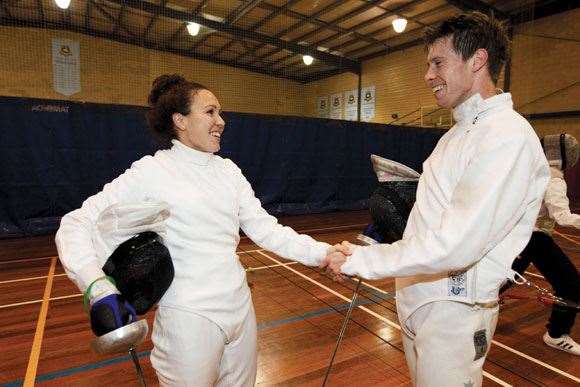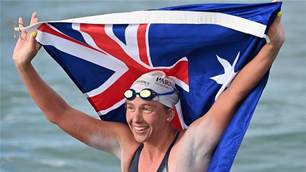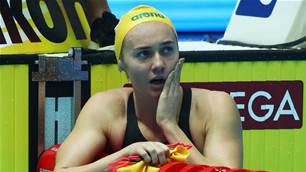The modern pentathlon ‒ how exactly did running, swimming, horse riding, fencing and pistol shooting get lumped together?
 Photos By, Kathy Watt
Photos By, Kathy WattThe modern pentathlon ‒ how exactly did running, swimming, horse riding, fencing and pistol shooting get lumped together?
The modern pentathlon might be one of those events concocted to baffle Olympic viewers ‒ how exactly did running, swimming, horse riding, fencing and pistol shooting get lumped together? But its pedigree is as Olympian as it gets. It was invented by Pierre de Coubertin himself, as the founder of the modern Games dreamed up a pursuit that would reflect the skill set required of a 19th-century French cavalry officer delivering a message. Hence, you have a sport which, action-wise, could only be matched by an Errol Flynn movie marathon.
Olympic modern pentathlon turns 100 in London, having been introduced in Stockholm in 1912, where the fifth-place finisher was an impetuous American army lieutenant named George Patton (women’s pentathlon, however, didn’t start until Sydney 2000). The history matters to Australian hopeful Chloe Esposito, who is heading to her first Olympics next month. Her father, Daniel, was Australia’s representative in the modern pentathlon at the 1984 Olympic Games in Los Angeles, an example which encouraged the young Chloe to take up the sport – or at least, all the parts of it together – at 13.
Now that the 20-year-old Esposito has made the Games, she’s set her sights on becoming the nation’s first medallist in the event. She’s currently the eighth-ranked woman in the world, with fifth- and third-place finishes at the top-level World Cup Series events earlier this year in the United States and Brazil respectively.
The modern pentathlon plays out over a gruelling single day of competition, and at these Games will culminate with equestrian and the new running/shooting event at Greenwich Park. In London, though, the waiting might be the hardest part – as the schedule stands right now, the women’s modern pentathlon will be the very last event to finish at the 2012 Olympics.
Modern family
“Modern pentathlon isn’t very popular in Australia; a lot of people don’t even know about it. I’d wanted to do it ever since I knew Dad went to the Olympic Games for pentathlon.
“A lot of people ask me: how do they [the competitors] find out about pentathlon? I think they get into it through other people. For me, it was because of Dad. I never saw him compete. When I was younger he told me about it; we saw some old memorabilia and stuff like that. I started pentathlon when I was 13, but I’d swum and run at school from when I was little. Gradually, I built up my skill in all the sports, and when I was 13 I started the full pentathlon.
“Normally it’s swimmers, or people with a swimming and running background, who cross over to pentathlon. I know a lot of people overseas get into it through pony club; they do horse riding, then they pick up the other events.
“When I started shooting for pentathlon,I entered a few shooting competitions on weekends ... I got picked up by a few of the coaches there and started going to a few shooting camps. My shooting just got better, so I started competing in major individual shooting events (Esposito made the 2010 Youth Commonwealth Games team in 10m air pistol). But it was always for pentathlon.”
How it works
“Modern pentathlon starts off with fencing; in the Olympic Games there are 36 competitors. We do ‘one-touch’ with everyone; whoever gets the hit wins
that match. It’s over in one minute. Whoever gets the most fencing hits will get the most points.
“After that, it’s not ‘one discipline straight into another’ like triathlon. We’ll have an hour and a half’s break before the next event ‒ the 200m swimming race. The faster time you swim, the more points you get.
“Next is horse riding. We draw a number out of a hat which links up to a horse. You get 20 minutes to warm up with that horse. We get five jumps’ warm-up, and then we do a 12-obstacle course. There’s a maximum of 1200 points on offer. For every mistake – knockdown, refusal or falling off! – they deduct points. After those three events they tally the scores.
“The last event is the running and shooting. It’s a handicap start; whoever’s on the most points will start first and however many points you are behind equals your seconds handicap. We run to the shooting range. We need to get five successful shots, then we run a kilometre, five shots, a kilometre, five shots and then a kilometre to the finish. Whoever crosses the line first wins.”
Related Articles

I was not born to run

Australian Chloë McCardel is now Queen of the English Channel













